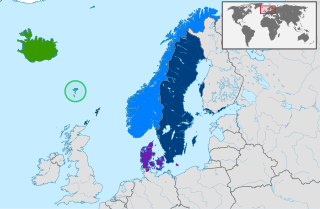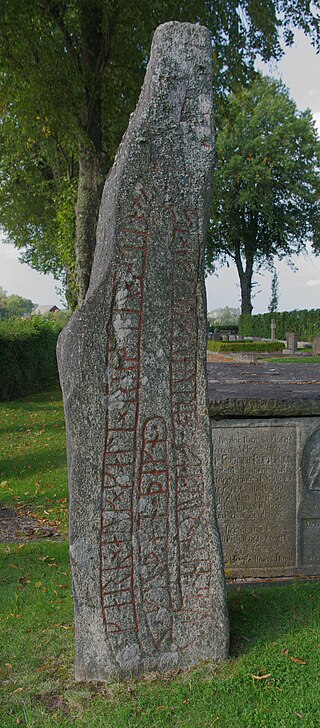A kenning is a figure of speech in the type of circumlocution, a compound that employs figurative language in place of a more concrete single-word noun. Kennings are strongly associated with Old Norse-Icelandic and Old English alliterative verse. They continued to be a feature of Icelandic poetry for centuries, together with the closely related heiti.

Norwegian is a North Germanic language from the Indo-European language family spoken mainly in Norway, where it is an official language. Along with Swedish and Danish, Norwegian forms a dialect continuum of more or less mutually intelligible local and regional varieties; some Norwegian and Swedish dialects, in particular, are very close. These Scandinavian languages, together with Faroese and Icelandic as well as some extinct languages, constitute the North Germanic languages. Faroese and Icelandic are not mutually intelligible with Norwegian in their spoken form because continental Scandinavian has diverged from them. While the two Germanic languages with the greatest numbers of speakers, English and German, have close similarities with Norwegian, neither is mutually intelligible with it. Norwegian is a descendant of Old Norse, the common language of the Germanic peoples living in Scandinavia during the Viking Age.

Old Norse, Old Nordic, or Old Scandinavian is a stage of development of North Germanic dialects before their final divergence into separate Nordic languages. Old Norse was spoken by inhabitants of Scandinavia and their overseas settlements and chronologically coincides with the Viking Age, the Christianization of Scandinavia and the consolidation of Scandinavian kingdoms from about the 8th to the 15th centuries.

The North Germanic languages make up one of the three branches of the Germanic languages—a sub-family of the Indo-European languages—along with the West Germanic languages and the extinct East Germanic languages. The language group is also referred to as the Nordic languages, a direct translation of the most common term used among Danish, Faroese, Icelandic, Norwegian, and Swedish scholars and people.
Nynorsk is one of the two official written standards of the Norwegian language, the other being Bokmål. From 12 May 1885, it became the state-sanctioned version of Ivar Aasen's standard Norwegian language (Landsmål), parallel to the Dano-Norwegian written standard known as Riksmål. The name Nynorsk was introduced in 1929. After a series of reforms, it is still the written standard closer to Landsmål, whereas Bokmål is closer to Riksmål and Danish.
Othala, also known as ēðel and odal, is a rune that represents the o and œ phonemes in the Elder Futhark and the Anglo-Saxon Futhorc writing systems respectively. Its name is derived from the reconstructed Proto-Germanic *ōþala- "heritage; inheritance, inherited estate". As it does not occur in Younger Futhark, it disappears from the Scandinavian record around the 8th century, however its usage continued in England into the 11th century, where it was sometimes further used in manuscripts as a shorthand for the word ēðel ("homeland"), similar to how other runes were sometimes used at the time.

A rune is a letter in a set of related alphabets known as runic alphabets native to the Germanic peoples. Runes were used to write Germanic languages before they adopted the Latin alphabet, and for specialised purposes thereafter. In addition to representing a sound value, runes can be used to represent the concepts after which they are named (ideographs). Scholars refer to instances of the latter as Begriffsrunen. The Scandinavian variants are also known as fuþark, or futhark, these names derived from the first six letters of the script, ⟨ᚠ⟩, ⟨ᚢ⟩, ⟨ᚦ⟩, ⟨ᚨ⟩/⟨ᚬ⟩, ⟨ᚱ⟩, and ⟨ᚲ⟩/⟨ᚴ⟩, corresponding to the Latin letters ⟨f⟩, ⟨u⟩, ⟨þ⟩/⟨th⟩, ⟨a⟩, ⟨r⟩, and ⟨k⟩. The Anglo-Saxon variant is futhorc, or fuþorc, due to changes in Old English of the sounds represented by the fourth letter, ⟨ᚨ⟩/⟨ᚩ⟩.

Danish, Norwegian and Swedish are all descended from Old Norse, the common ancestor of all North Germanic languages spoken today. Thus, they are closely related, and largely mutually intelligible, particularly in their standard varieties. The largest differences are found in pronunciation and language-specific vocabulary, which may hinder mutual intelligibility to some extent in some dialects. All dialects of Danish, Norwegian and Swedish form a dialect continuum within a wider North Germanic dialect continuum.
Old Swedish is the name for two distinct stages of the Swedish language that were spoken in the Middle Ages: Early Old Swedish, spoken from about 1225 until about 1375, and Late Old Swedish, spoken from about 1375 until about 1526.

Uff da is an American Scandinavian exclamation or interjection used to express dismay, typically upon hearing bad news. Of Norwegian origin, the phrase was brought by Scandinavian Americans to the Upper Midwest, New England, and Pacific Northwest regions of the United States during the 19th century, where its meaning was broadened to express also surprise, astonishment, exhaustion, or relief.
In historical Germanic society, nīþ was a term for a social stigma implying the loss of honour and the status of a villain. A person affected with the stigma is a nīðing . Middle English retained a cognate nithe, meaning 'envy', 'hate', or 'malice'.

Odin is a widely revered god in Germanic paganism. Norse mythology, the source of most surviving information about him, associates him with wisdom, healing, death, royalty, the gallows, knowledge, war, battle, victory, sorcery, poetry, frenzy, and the runic alphabet, and depicts him as the husband of the goddess Frigg. In wider Germanic mythology and paganism, the god was also known in Old English as Wōden, in Old Saxon as Uuôden, in Old Dutch as Wuodan, in Old Frisian as Wêda, and in Old High German as Wuotan, all ultimately stemming from the Proto-Germanic theonym *Wōðanaz, meaning 'lord of frenzy', or 'leader of the possessed'.

The Rus', also known as Russes, were a people in early medieval Eastern Europe. The scholarly consensus holds that they were originally Norsemen, mainly originating from present-day Sweden, who settled and ruled along the river-routes between the Baltic and the Black Seas from around the 8th to 11th centuries AD. In the 9th century, they formed the state of Kievan Rusʹ, where the ruling Norsemen along with local Finnic tribes gradually assimilated into the East Slavic population, with Old East Slavic becoming the common spoken language. Old Norse remained familiar to the elite until their complete assimilation by the second half of the 11th century, and in rural areas, vestiges of Norse culture persisted as late as the 14th and early 15th centuries, particularly in the north.

In Old Norse, seiðr was a type of magic which was practised in Norse society during the Late Scandinavian Iron Age. The practice of seiðr is believed to be a form of magic which is related to both the telling and the shaping of the future. Connected to the Old Norse religion, its origins are largely unknown, and its practice gradually declined after the Christianization of Scandinavia. Accounts of seiðr later made it into sagas and other literary sources, while further evidence of it has been unearthed by archaeologists. Various scholars have debated the nature of seiðr, some of them have argued that it was shamanic in context, involving visionary journeys by its practitioners.

In Norse mythology, Sváfa or Sváva is a valkyrie and the daughter of king Eylimi. Consequently, she was probably the maternal aunt of Sigurd, the dragon slayer, although this is not explicitly mentioned in Helgakviða Hjörvarðssonar where Sváfa's story appears.

The Holmby Runestone, listed as DR 328 in the Rundata catalog, is a Viking Age memorial runestone bearing the image of a ship. It is in Holmby, which is about two kilometers southeast of Flyinge, Scania, Sweden.

The Skern Runestone, designated as Danish Runic Inscription 81 or DR 81 in the Rundata catalog, is a Viking Age memorial runestone located in the small village of Skjern, Denmark between Viborg and Randers. The stone features a facial mask and a runic inscription which ends in a curse. A fragment of a second runestone designated as DR 80 was also found in Skjern.

The Källby Runestones are two Viking Age memorial runestones located in Källby, Västra Götaland County, Sweden, which was in the historic province of Västergötland.

Västergötland Runic Inscription 73 or Vg 73 is the Rundata catalog number for a Viking Age memorial runestone that is located near the Synnerby church, which is about nine kilometers west of Skara. The stone was raised in memory of a man who was a thegn.

The Strängnäs stone, or runic inscription Sö Fv2011;307, is a runestone inscribed with runes written in Proto-Norse using the Elder Futhark alphabet. It was discovered in 1962, when a stove was demolished in a house at Klostergatan 4, in Strängnäs, Sweden. The stone is of Jotnian sandstone and measures 21 centimetres (8.3 in) in length, 13 centimetres (5.1 in) in width and 7.5 centimetres (3.0 in) in thickness.
















